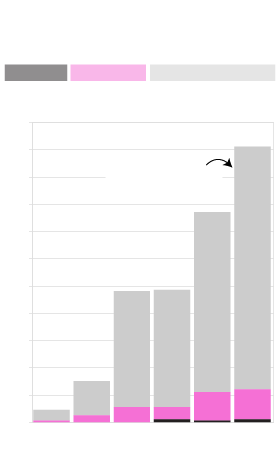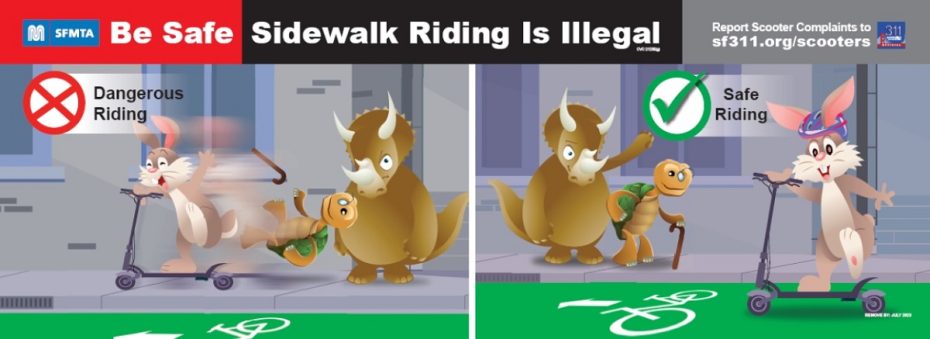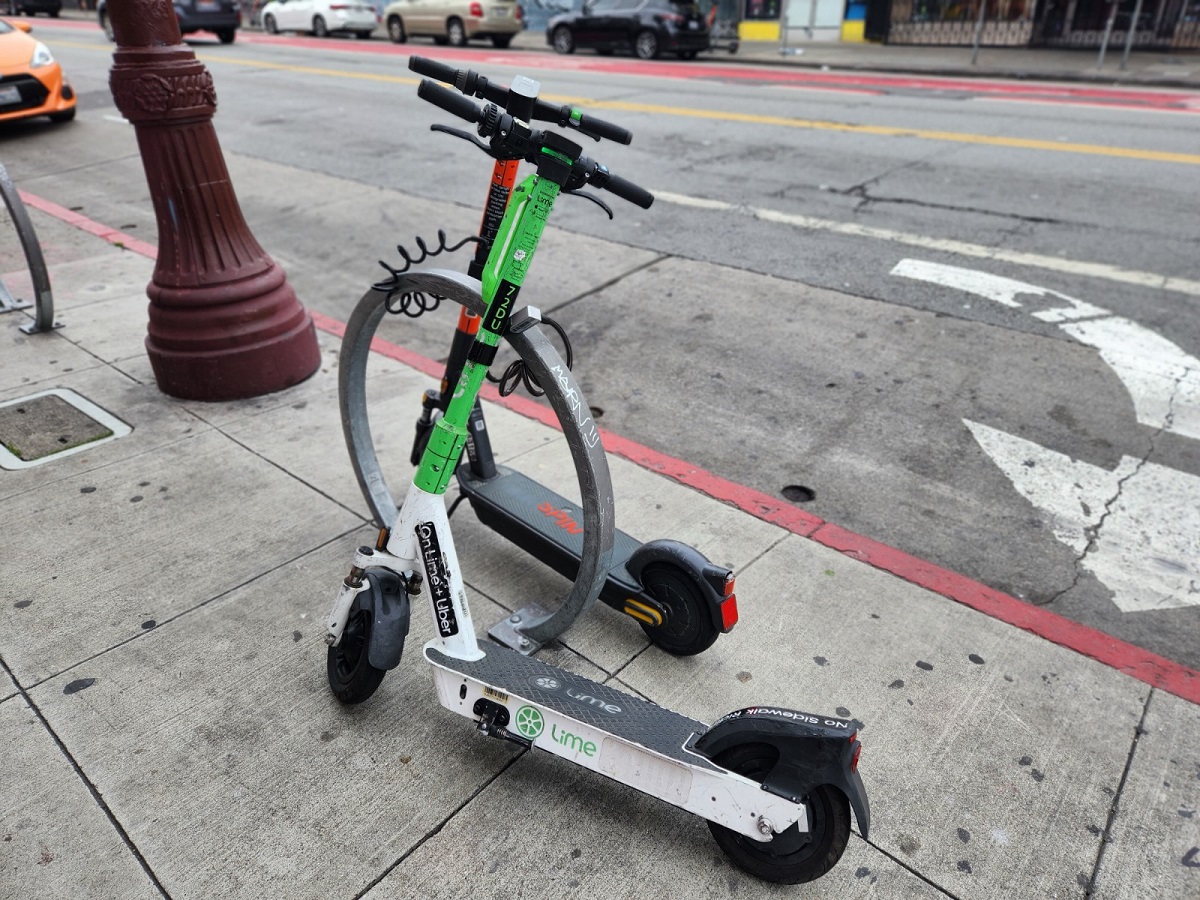According to a Mission Local analysis of city data, injuries from electric scooter collisions rose 31 percent in 2022, making it the fifth year in a row that figures have increased.
The vast majority of these collisions were cars and trucks striking scooter riders. And, while the city is pushing new guidelines for safe scooter use, advocates say that not enough has been done enough to reshape city streets to accommodate this new form of transportation.
More than 200 injuries related to electric scooters were recorded in 2022, including two that were fatal and 22 that were classified as “severe.” These figures include Mission resident Abraham Joshua, who was struck and killed by a truck driver while riding his scooter in March, 2022.
Scooter collisions make up only 7 percent of overall crashes in the city, but the steep year-on-year increase raises concerns that scooter riders are particularly vulnerable to larger vehicles.

Scooter injuries increased for the fifth year in a row
Collisions involving scooters
Fatal injury
Severe injury
Mild to moderate injury
220
200
Scooter injuries rose
31 percent last year
180
160
140
120
100
80
60
40
20
0
2017
2018
2019
2020
2021
2022

Scooter injuries increased
for the fifth year in a row
Fatal injury
Severe injury
Mild to moderate injury
Collisions involving scooters
220
200
Scooter injuries rose
31 percent last year
180
160
140
120
100
80
60
40
20
0
2017
2018
2019
2020
2021
2022
Chart by Will Jarrett. Data from TransBASE.
“It feels like every night is now a scooter night,” said Dr. Chris Colwell, the chief of emergency medicine at Zuckerberg San Francisco General Hospital. “And these are pretty significant injuries.”
On a recent Friday, Colwell recalled, the department cared for five people with scooter injuries. One patient had a collapsed lung and another had major head trauma. The rest were sporting a panoply of fractured bones.
“Their injuries were essentially the same as if a car hit a pedestrian,” he said. “They were not protected, at all, by the scooters.” He added that he expected that the number of injuries recorded by the city was a significant undercount.
The city uses TransBASE data as one of its main ways to analyze trends in traffic collisions. Although detailed, it is not a perfect source. Crashes are only recorded if the police submit an incident report, or if an injured party visits the hospital and is correctly documented.
There is also some gray area in how crashes are categorized. Last year, Brianna Rader was hit at 21st and Valencia while riding her scooter. Her injuries were severe, but in TransBASE the crash is recorded as occurring between a car and an indeterminate “motor vehicle” – so it is not counted in any total for scooter collisions.
It is unclear how often this kind of misclassification occurs but it can even be hazy with fatal collisions. For example, Kevin Radcliffe was killed riding an electric unicycle near Oak and Octavia streets last year, and his death was counted in the electric scooter category. Rosalyn Barnett died in a scooter crash in the Tenderloin, and was counted as a “motorized scooter” death rather than an electric scooter fatality.
Nonetheless, because the methodology behind TransBASE remains the same year-on-year, it can still show broad trends in types of injuries, even if there are likely undercounts. And the data suggests that scooter injuries are growing rapidly.
Who is getting injured?
Last year, men outnumbered women in scooter injuries by more than three to one. The injured parties were typically young-ish, with the median age hovering at 36. Most crashes occurred in the northeast of the city, around downtown and South of Market; perhaps unsurprisingly, as that is where the biggest chunk of journeys took place.
In these crashes, the people riding scooters were much more likely to get hurt than they were to injure anyone else. Scooter riders were injured in 95 percent of scooter-related crashes in 2022, while the other party was injured roughly 13 percent of the time. The latter kind of crash typically involved a scooter rider crashing into a pedestrian.
The most common type of scooter collision, according to TransBASE, was a passenger car “broadsiding” a scooter while they were going straight across an intersection.
In a little over half of last year’s collisions, the scooter rider was found to be “at fault.”
Why are injuries climbing?
The most obvious answer: Scooters are being used more.
“Injuries caused by any type of transportation would increase the more that transportation mode is used,” said Jacob Tugendrajch, a representative for the scooter company Lime. “It’s why car crashes went up from the time before the introduction of the Model T to the years after.”
But city data shows that usage of scooter-share companies like Lime and Spin, which operate 2,000 rental scooters each throughout San Francisco, only rose about 2 percent between 2021 and 2022, not enough to explain the jump in injuries.

Scooter rides (millions)
1.8
1.6
Bird*
1.4
1.2
Jump
Spin
1.0
Skip
0.8
After a pandemic
lull, rental scooter
rides rose a lot
in 2021 and
slightly in 2022.
0.6
Lime
0.4
0.2
0
2019
2020
2021
2022
*Bird announced that it was pulling out of San Francisco in early 2023

Scooter rides (millions)
1.8
1.6
Bird*
1.4
1.2
Jump
Spin
1.0
Skip
0.8
After a pandemic
lull, rental scooter
rides rose a lot
in 2021 and
slightly in 2022.
0.6
Lime
0.4
0.2
0
2019
2020
2021
2022
*Bird announced that it was pulling
out of San Francisco in early 2023
Chart by Will Jarrett. Data from the San Francisco Municipal Transportation Agency..
Tugendrajch also said that Lime’s internal data showed a 52-percent drop in incidents that required medical treatment between 2021 and 2022. John Lankford, a senior director for scooter company Spin, declined to share internal data, but said that “only a tiny fraction of rides taken result in any kind of injury.”
If rides on city-affiliated scooters have not gone up much, and may even be getting safer, then why are more people getting hurt? It could be that more people are riding private scooters.
Ryan Parkes is a sales rep and repairman at the scooter and e-bike store The Last Mile, based at Ivy and Octavia streets. He said that electric scooter sales had been high in 2021 and early 2022, with maybe 50 sold each week. Although sales have since fallen off somewhat, he said that they are seeing a steady stream of riders who need repairs, suggesting that the scooters are still being used regularly.
“They are sometimes a little beat-up because they took a bad turn, got hit by a car, fell off,” said Parkes. “That is not unusual.”
Private scooters are not as strictly regulated as those loaned out by Lime and Spin. According to California state law, it is illegal to operate a powered scooter faster than 15 miles per hour, and Lime and Spin scooters include speed limiters to theoretically keep riders from exceeding that top boundary. But some private scooters being sold in San Francisco are advertised with top speeds of 55 miles per hour or even more.
City-permitted scooter companies are also incentivized to minimize dangerous riding. For instance, every reported incident of riding on the sidewalk could see them slapped with a fine of up to $500. Lankford from Spin said that they “suspend users from our system who we know to be using our vehicles unsafely.” In contrast, private scooters are not regulated by the city, although the police can still intervene to stop dangerous scooting.
It is hard to know how many private scooters are being used in San Francisco, because the city does not track private trips. But private scooters do seem to appear more regularly in the city’s injury data than city-permitted ones, suggesting fairly high usage.
What is being done to prevent injuries?
Even taking into account the departure of scooter company Bird from San Francisco in February, which meant the loss of 1,500 permitted scooters, it seems likely that this new mode of transport will be a feature of the city’s streets for the foreseeable future. Advocates and city officials have floated a raft of approaches to help keep scooter riders safe.
General Hospital’s Dr. Colwell said that riders could improve their personal safety by wearing helmets, and not using scooters while drunk. “We don’t want to frighten people off the scooters,” said Colwell. “But we do want people to respect them.”
The San Francisco Municipal Transportation Agency announced a new public safety campaign to advise scooter riders on Monday. Their guidance revolves around three “golden rules:” Not riding faster than 15 miles per hour, not having more than one person on a scooter, and not riding on the sidewalk.

Stephen Chun, representative for the agency, said that the city has worked to improve bike and scooter infrastructure by adding more than 3,000 additional parking racks since the scooter permit program began in 2018. He said that the city has some 465 miles of bikeways that could be used by scooters.
Chun added that “smart regulation” of scooter companies aimed to balance “innovative mobility technologies with our goal of keeping our streets and sidewalks safe and accessible.”
But sustainable transportation advocate Luke Bornheimer said that the agency has focused too heavily on “punishing scooter companies” with measures like the aforementioned $500 fine. Instead of issuing fines when scooter riders mount the sidewalk, said Bornheimer, the city should make it safer to use scooters properly. It could do this by building up bike lanes that are physically separate from roads and intersections that do not put scooters at risk, he said.
“If we want more people to use sustainable transportation, to reduce roadway injuries and deaths, to reduce pollution and car traffic,” said Bornheimer, “the single most effective way to do that is protected bike infrastructure.”
It is certainly true that San Francisco has not realized its traffic infrastructure goals over the last decade. In 2014, the ambitious Vision Zero was launched with the aim of reaching zero traffic deaths within 10 years.
Last year, there were 39 traffic deaths in the city, the highest figure since the program began. At least two of those fatalities were people riding electric scooters.
Explore six years of city scooter injuries
Map by Will Jarrett. Basemap by Mapbox. Data from TransBASE.


ENFORCEMENT of all laws, please!
A not-insignificant segment of electric scooter users are failing to implement basic safety measures. I regularly observe scooters traveling the wrong direction at quite a fast clip along bike lanes; zipping along sidewalks at speeds unsafe for pedestrians; many wear no helmets; some are riding with a passenger on a scooter designed for a single user, including adults ferrying their small kids on these, which is so treacherous. As a pedestrian I have leapt out of the way of a scooter speeding along the sidewalk and the operator of that scooter took no evasive action nor did they slow to a safer speed, and I resent the widespread carelessness with which these are operated.
Electric scooters are fantastic vehicles if there weren’t other factors like pedestrians and automobiles within the same space. The mix ain’t good. I don’t have a lawn but please get off my sidewalk.
My experience tells me that the scooters are much more likely to be at fault. When they come off of the sidewalk and enter the crosswalk at a high rate of speed, it’s almost impossible for the driver to anticipate and stop in time. They are moving from one pedestrian walkway where pedestrians are at risk into another pedestrian walkway where most drivers wouldn’t expect to see anyone come out of the blue at that fast a rate of speed. While we are talking about dangerous behavior, many jay walkers are either elderly or have a disability. They are clearly unable to navigate a jay walking maneuver but it doesn’t seem to deter them from trying.
The least safe thing on the streets are potholes. Fix the potholes and people will be less liable to lose their balance. If pothole can take out a car, imagine what it can do to a scooter.
I rode motorcycles for decades with one accident my first week ( train tracks). I have difficulty feeling sorry for scooter riders, watching how little they follow safety rules, much less laws.
Now I’m 78 and fear being hit by bikes, scooters and even motor scooters on the sidewalk/ crosswalks.
Maybe our cops could stop busting homeless people with shopping carts and bring some order to the streets. The SFPD should be good for something.
Before we rearrange SF’s streets to accommodate a very small minority, let’s insist on scooter riders getting some training and using helmets. Bike riders too need to use better sense (for example, not riding at night while wearing dark clothing and not having lights or reflectors) and need to have their bikes registered and insured, like cars.
Both groups need to stay off the sidewalk. There are abundant bike lanes in SF, with the bike groups demanding more each time there is an accident. A lot of us do potentially dangerous sports and do not demand that the environment be rearranged to accommodate us. Getting training, using proper protection, and respecting the rights of others make the city safer fore everyone.
>A lot of us do potentially dangerous sports and do not demand that the environment be rearranged to accommodate us.
This type of broad brush statement is offensive. My biking has been to go to work. I couldn’t afford a car. Do I deserve to die just because you choose to do dangerous sports in your leisure time?
Is helmet use captured in any ER/accident data?
Over half are the riders fault. Perhaps there should be training and licensing for all these newer unregulated powered bikes and scooters.
But who will enforce any regulations in the streets? It’s worth mentioning that there is virtually no SFPD moving-traffic enforcement to speak of and therefore very little incentive for ANY device on the street to behave civilly. SFPD embraced the work-from-home mentality by doing nothing at all 2-3 days every week and the bare minimum homicide investigation the rest of the time.
On blocks where the streets are made too dangerous by gig-workers driving Priuses
(without catalytic converters) in mid-block circles and doing 5-point turns, the scooters take to the sidewalks at high rates of speed, endangering pedestrians. I pine for the civil days of pedal-bikes and skateboards…..
Since, according to the article, a majority of the collisions are the fault of the scooter rider, shouldn’t the rental companies have better, enforced safety requirements? In Paris, Barcelona and other cities, the companies are mandated to limit speed of scooters. Also, in Paris, they are about to be banned because too many scooter riders ignore the safety of pedestrians. Over 80% of those who voted voted for banning them.
As a motorcycle rider, one must come to grips with – it’s not if you wacked or auger into the pavement – it’s when. These things are way more dangerous – in my two wheel opinion. Folks are zippin’ around with no helmets, street shoes (even flip flops!), no gloves, no nothin’. Results are as expected.
As with most things in SF gov, the public safety campaign is just performative.
On the flip side – business for facial re-construction plastic surgeons is a boooomin’. Seriously (friend of a friend intel) – think of that next time you get on one of those things.
I think these electric scooters are inherently unsafe. The idea of standing on such a narrow platform seems very unsound. These things are essentially motorized versions of the kind of push scooter a child would ride. Except now we’re in city traffic. Plus these things are scattered all over sidewalks. Like the driverless cars, allowing these things on city streets is a mistake.
Bornheimer also helped make JFK “safe” for distasteful Doggie Diner Heads, a hot dog stand (in the middle of the road!), a beer garden, tasteless “murals,” etc.
People CHOOSE to ride on sidewalks, and every street can not have a bike lane.
As I suspected, the bike corrals were put in as a subsidy to the scooter rental industry.
SF’s deadly bike infrastructure is to blame. For now, SF remains a car first city no matter what the city government says
Atlanta requires that all scooters cut off when a rider attempts to ride on the sidewalks. San Francisco has the same ability to require the scooter companies (like Lime Uber) to install the software that prevents scooters from operating on sidewalks. SFMTA has the authority to do so. Why don’t they?
In 2022 at a Board of Supervisors hearing on the subject: “That is the technology they [scooter companies] have,” Peskin said. “They can do it here, but they don’t, because it’s not part of their buinsess model.”
Supervisor Shamann Walton asked Joel Ramos, the local government affairs manager for the SFMTA, why the scooter companies aren’t using that technology to keep riders off the sidewalk. Ramos said we “have asked them to employ it … within the current permit structure.”
Walton: “Why are we asking and not demanding?”
Ramos: “There are terms of the contract we are trying to respect.”
And there lies the essence of the fundamental problem.
The scooters in the photo are parked in violation of the permit requirements. Rent-a-scooters (and bikes) are limited to two per public rack. They must be parked on the same side of the rack.